Caving "to New Horizons" In India
Caving in the Abode of Clouds - To New Horizons
Photos and Story by: Thomas Arbenz
Thomas and his team of scientists and explorers traveled through caves in India on a few different expeditions. To his surprise, packrafts were very helpful in measuring the caves and seeing the sights that cannot be seen above the ground. Check out a writeup he did about his expeditions and his use of packrafts within them.
"To New Horizons“, that’s what we had written on our flags for the Expedition because by the end of the previous year's expedition, we were quite sure that the Kopili and Pala region in the Jaintia Hills was pretty much "done“ after we had completed Krem Khung and shorter caves that left us standing in front of "terminal“ of boulder chokes or sumps. Yet, despite the motto, the first group of cavers arriving in Meghalaya headed out to the Pala Range once more. Simon had some unfinished business in the over 20km Tyngheng-Dieng Jem System and Thomas needed to go back to his beloved Krem Labit Kseh to complete some question marks. It was planned that this Pre-Expedition Week would be used to finish the job properly but, alas, the story turned out differently.
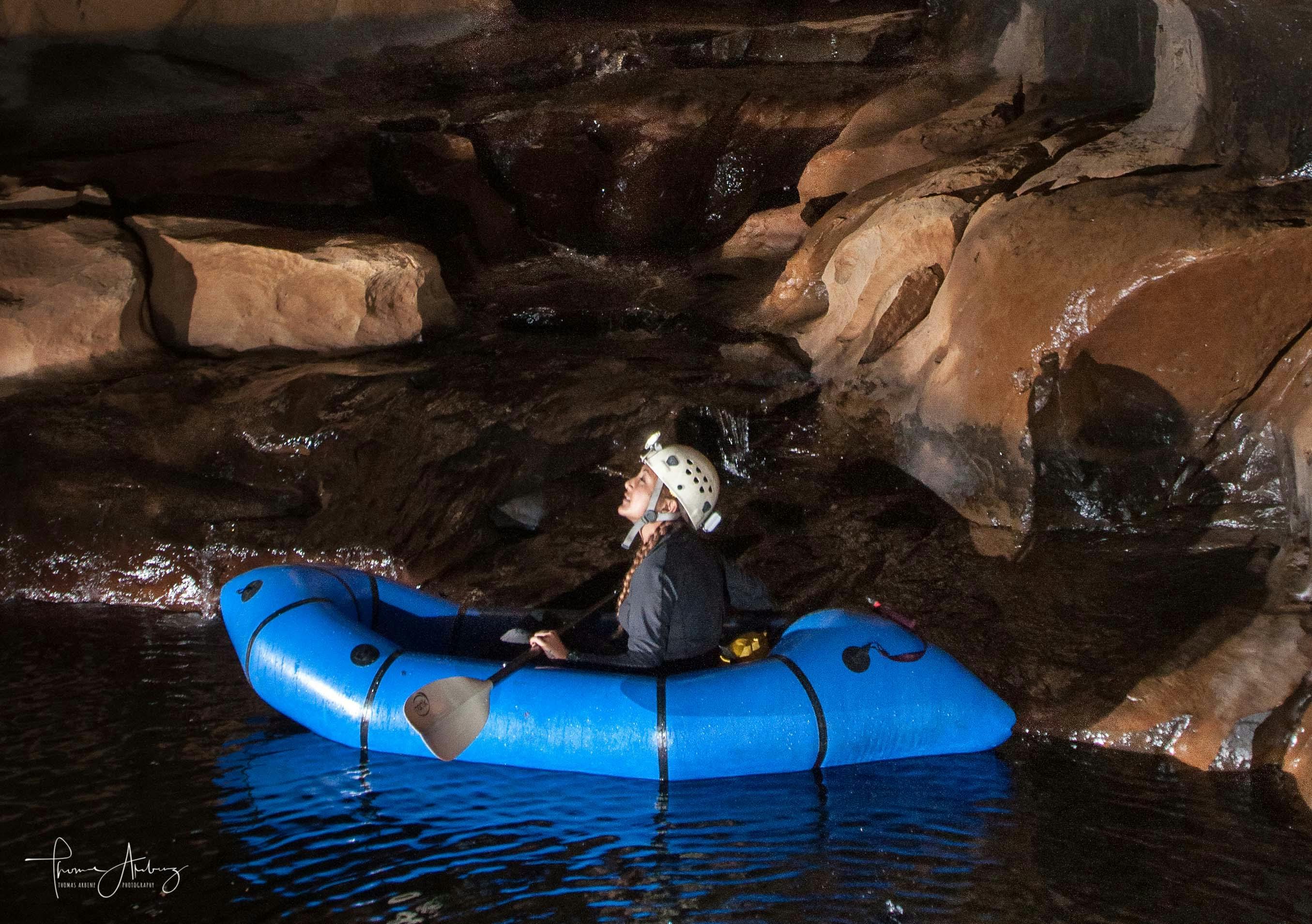
We had set up a basic camp (just tents, a mass tent and an open-air kitchen) in Umkyrpong, at the same site where the notorious 2010 camp had been. Two groups, led by Simon and Thomas respectively went about their tasks, but it wasn’t before long that the villagers arrived in the camp telling us about caves we had not known beforehand. The next day we ran into Brian and a party of cavers and locals heading for a recce to the North. They found two caves worth a closer look. The bigger one, Krem Lakhon, turned out to be a "Nugget“. In the few remaining days of the Pre-Expedition week, with a caving team of 11 in total, we surveyed over 2.5 km of new passage. And, to no big surprise, the cave was "still going“ when we had to leave the area to join the bigger team for the main event.
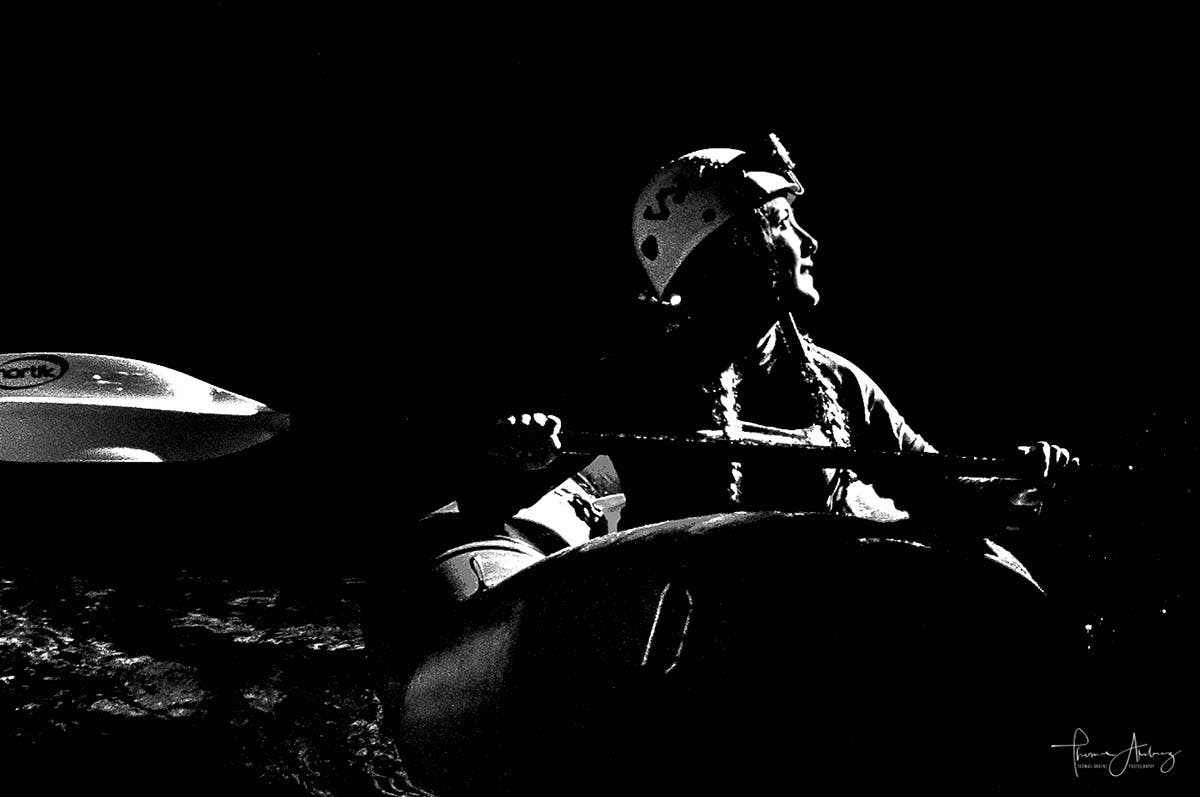
As we were there, we were also on a mission to test a new piece of equipment: We wanted to find out how useful to caving and how sturdy packrafts are. A packraft was lent to us by our friend Zorba Laloo, who had recently started to bring Alpacka Raft packrafts into Meghalaya. To my knowledge packrafts are have not been used too much in caves to date. Still questioning whether they would hold up, we soon realized that they were built from high tech fabrics, lightweight and sturdy, and laner than the common dinghy feeling like a kayak. Their great advantage is their packing size. The model we used was when deflated rolled to the size of a sleeping bag and weighing only around 4kg – all in all, great features for caving application.
The first (ever) trip took us to Krem Labit Kseh, where some side passages still waited to be surveyed. Myself and Fraser, being experienced kayakers brought the Alpacka Raft out and started off upstream along the first 800m of stream passage. Assisted by Henry and Richa, we soon got acquainted to the packraft taking turns so everyone could have a go. We found that they were great to transport a person plus up to 3 kit bags and easily maneuverable. Arriving at the first gour dams and the 5m cascade we really felt the advantage of the light weight. Carrying the raft along and pulling it up the gours was indeed a “piece of cake”. Trailing it along shallow sections didn’t do it any harm either. The unanimous judgment was: very useful in stream caves.
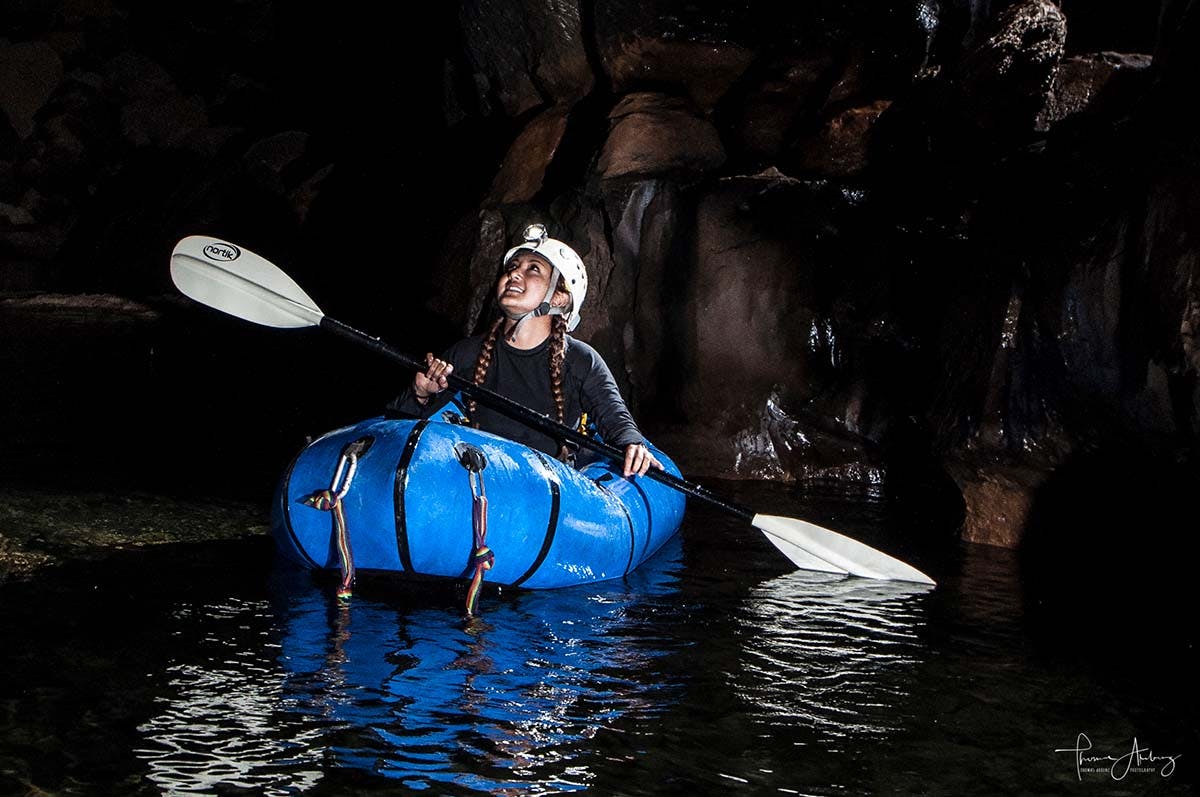
Krem Lakhon.
The entrance was high and wide and a big chamber with a number of skylights through one of which was the 6m access climb down to the floor. The entrance chamber lead into a streamway, and the explorers soon got wet, wading in up to chest-deep water. A few dead rodents and bats were found floating in the water and a floor consisting of soft, yellow slimy mud were not for high spirits. However, at some points along the streamway, there were some high level passages. After 30 survey stations, Simon made a traversing climb into a dry high level relic passage that was both large and on-going.
Two leads were now to be followed: the murky streamway and the upper relic passage. The latter turned out to be nicely decorated and jelded 390m of new cave before it closed back to the streamway. Also the upstream branch was pushed to a boulder choke some 500m away. Numerous sidepassages, most of them relic, were looked into and surveyed. Then the cavers arrived at a 8m pitch. At the base of this several side passages could be mapped but the highlight was a 40m diameter chamber with a 40+ maven and an ongoing passage at the far end. In the upper parts a second team found again a vast ongoing passage, inhabited by a colony of about 500 bats and decorated with extraordinary nice gypsum crystals. Both big leads plus some smaller ones were left for our next expedition.
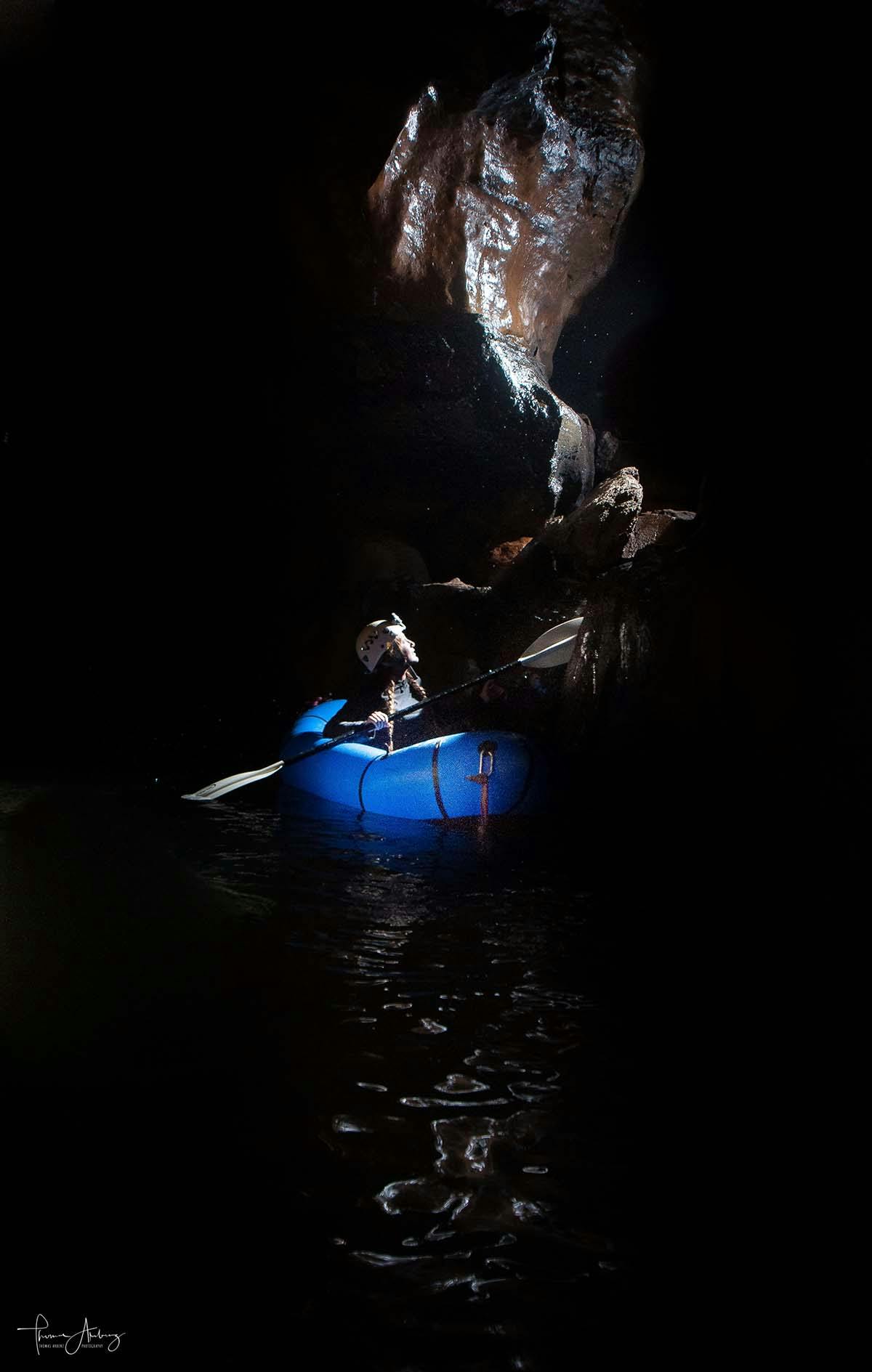
Main Expedition
The bigger part of the expedition was indeed dedicated "to new horizons“. A merry crew of 30 cavers had travelled to Shillong by the second week of February.
As usual they met at Maureen’s Place, dug into the store room and got personal and expedition gear out, checked and loaded. On Sunday morning the newcomers boarded their Sumos and left Shillong to get to Kharkhana via the Dauki Road. The Pre-expedition group had travelled ahead not going back to Shillong, but taking a shortcut through the Suntga coal belt.
After "breakfast in Dodge“, as Fraser put it, they turned their backs to notorious Lad Rymbai, heading south west towards new ground and new adventures. They left the dirty coal belt and were soon driving into a pleasant area with a lot of green jungle. The blacktop road took them to Lama and then some off-road action took place. The winding jungle road down to Baghmara got more and more wet and muddy – and slippery. They reached the Myntdu River but the supposedly new bridge was far from being completed. An “interesting” crossing followed by some more off-road action on a steep hill eventually brought them to their new campsite: the school grounds of Kharkhana, where they were welcomed by village officials and a good part of the village population. Camp was set up and soon the newly arrived members of the main expedition rode in. Old friends were greeted, new acquaintances made and the first dinner was served.
Kharkhana lies merely 300 feet above sea level, at the foot of the 3,000 feet cliffs that form the southern border of Meghalaya. We were hoping for caves in limestone layers that we thought would lay upstream of the Myntdu river. The recce upstream was done by a mixed fleet of Khasi transport canoes and a couple of Zorba’s Alpacka Raft packrafts. Again the packrafts proved to be a great advantage: light-wight as they are they are really easy to portage on the “dry bits” of the stream. However, the recce along the Myntdu din’t yield any caves, the nearer area was mostly sandstone. Therefor the first caves we heard of were rather small ones. Still, on Monday several teams vanished in the extended Areca Nut (Betel Nut) plantations and the jungle guided by groups of locals to find and survey these caves. From several short caves they brought back data to process in the evening but only two caves proved to be of bigger interest.
One was Krem Hartali, a rift and temporary streamway with nice formations. It also was of much interest to the biologists as it lay only 20mins away from the camp and had a rich cave fauna to study. The second cave of interest was what we would call "a jackpot“. The name and location will not be reveald here for reasons you may find out from Annie’s description:
"...... they returned to the area that Roger and team were surveying the previous day to tidy up some side passages. One of these began to look promising as it was opening up into a large boulder choke. Just as we were about to leave this to finish for the day, Cookie spotted a beautiful and complete earthen pot, set on the ground among cave pearls in a small well decorated chamber. It had clearly been placed in its position and not washed or fallen in, and it also had a small stalagmite growing on it so had obviously been there for some time. There were some other broken pieces of pot beside it. There was a stunned silence as we realized that we were potentially in a burial site and that the other pots, found earlier, could have a similar significance. At the other side of the chamber, underneath an overhanging rock, Roger spotted the rim of another pot which was almost completely buried.“
During the following days more pots and shards were discovered along with some bones that were presumably human. A lager team accompanied Elena the photographer into the cave and took the time to thoroughly photograph the finds. Everything was left in place. Brian would later present some of the photos to the Dean of the Hill State University, and see if a proper archeological search was possible.
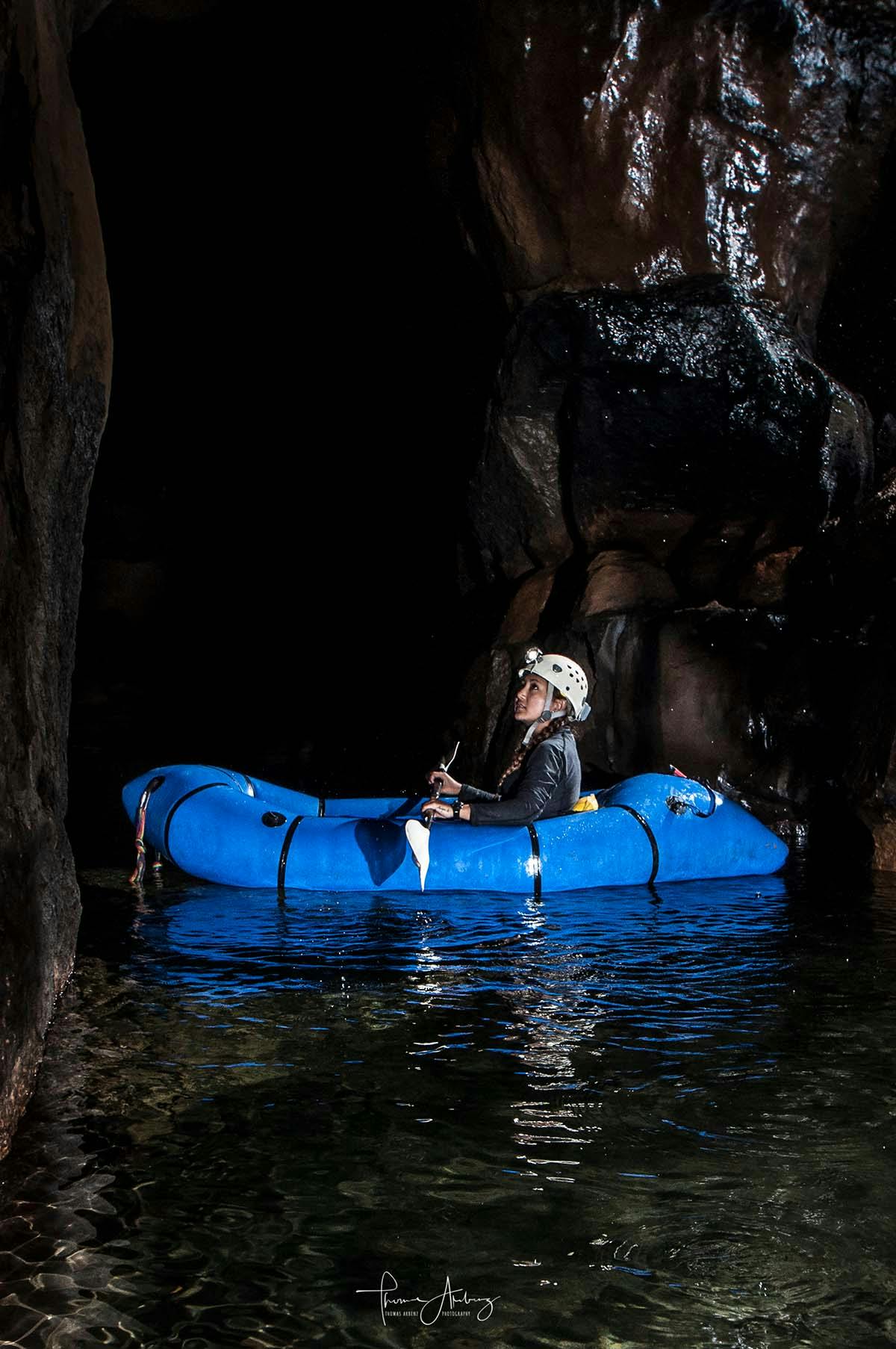
Now that we were aware of the fact that at such a low altitude there were no big caves to be discovered, we had to head for higher grounds. This proved to be the right strategy which Jos and Marcel along with a mixed crew of cavers and locals were about to find out. The arduous scramble up on jungle paths and steep sandstone steps brought them to a big doline at about 1,200 feet altitude. At its bottom they discovered a high and wide entrance that gave access to a big chamber: Krem Pdeng Laphiang. The enthousiastic "Wow“s and "Aah“s were soon muted because there seemed to be no way on from the chamber. But not wanting to immediately give in to fate the explorers started to probe at different spots in the boulder strewn floor and finally found a squeezy access to a lower horizontal passage. As the expedition went on, this type of cave turned out to be typical for the area at mid level altitude: They are what you may call "contact caves“ – starting in sandstone, developing along the sandstone and Limestone interface and then dipping into limestone. They often consisted of roundish boulder choked entrance chambers with a stream-way below, that eventually petered out in too tight rifts. Krem Um Thalong which was explored by Thomas, Peter, Elena, Brian, and Tudor was almost a copy of Krem Pdeng Laphiang, as was Krem Mummum to the east of Lakadong.
As teams got to the east of the Myntdu at the same altitude, a different type of "contact cave“ cave was discovered which became also quite typical fort he area. These caves were completely developed along the horizontal interface between the top sandstone and the lower limestone. The most interesting of them was Krem Um Sapnar, a fine stramway cave with plenty of impressive formations "growing“ on sandstone and limestone alike. Des,Vijay, Richa, Bhushan, Jos and Thomas surveyed a good 700 meters of this cave before they had to declare defeat as the galleries got gradually too tight.
Looking for more caves took the recce teams up to the Lakadong Plateau. The village of Umlathdoh was visited and quickly adopted by the caving community. Of course this was because of the three "big ones“ that were shown to us by the local guides: Krem Lum Jingtep, Krem Pdein Dharai and Krang Lapaw. But it wasn’t only the caves that made the place so attractive. Equally important was the fine Dukan Sha (tea shop) at the village entrance. Here Marissa would unload the pack of cavers she had badly shaken up on the long and bumpy ride up from Kharkhana and here she would eventually pick up a tired and dirty crew again after a good day of caving and surveying. The tea shop, or better the tea shop lady did a lot of good to keep spirits high as apart from the arduous rides on Marissa the weather was sometimes also pitiable – wet and foggy with a touch of Chinese laundry.
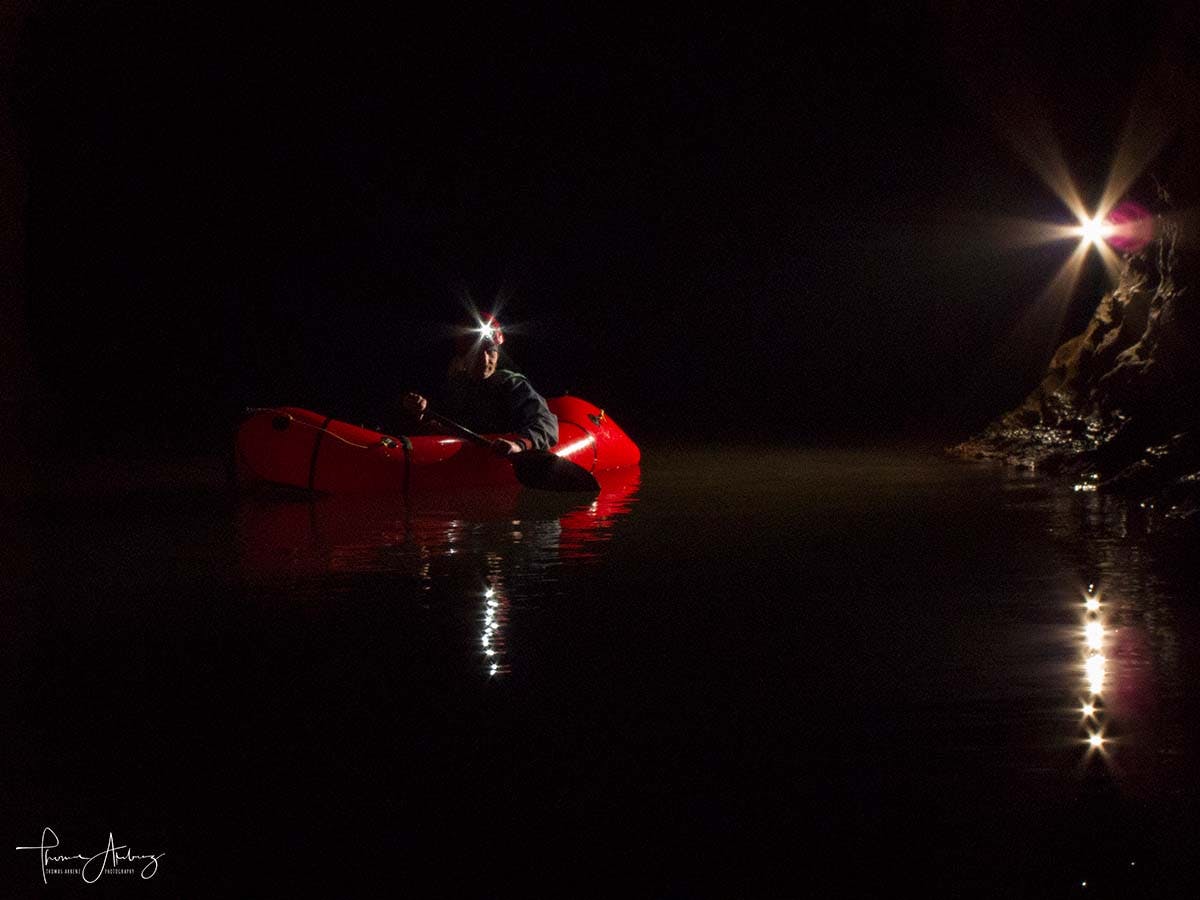
So much could be said about the 3 big caves in the area but the most interesting was Krem Pdein Dharai which was also the longest cave we explored, measuring a nice 3.1km in length. To start with it looked much "the same as usual“ with its big, arches and boulder strewn entrance chamber. But then two pitches gave access to a fantastic streamway of 20m hight and 5m width heading off to the north. Richard, Cookie, Roger and Des were leading the exploration later joined by Jos and Marcel. Simon had as well a go at it especially when it came to the faraway reaches and to clocking up the last meters for the expedition total of no less than 12km. The nicely decorated streamway stayed at the same dimensions for the better of 600 meters making progress easy which was much welcomed especially on the way back when the 27m pitch had to be negotiated – a pitch that for some twisted mood of mother earth bore a microclimate of steaming heat. Upstream the cave would fork, one branch going on to the north, one to the north-east on two levels. The explorers encountered many features of high interest, one of which was a cluster of strange looking formation in colors from the usual ochre through a vivid pink to a pale blue. It is suspected that this coloring is not a "natural beauty“ but rather due to petrified mine sewage brought in during the first coal rush decades ago. One other feature worth mentioning is what Des described as a very impressive if not unique boulder chamber: "when I say boulder chamber I don’t mean a chamber with boulders in it, I mean a boulder with a chamber in it!!”
Well, I could go on almost endlessly, so many great impressions we got every day and so many adventures we lived again and again. But I will leave the final lines of this tale to Zorba Laloo. He came as a visitor and novice to the expedition for a couple of days and left as a friend who was deeply impressed by what the "world beyond darkness“ had given to him:
"Massive chambers that entire houses could fit in, stalactites and stalagmites, calcite formations, sparkly mineral deposits that reflect lights, entering places that are probably older than anything else above ground, and an overwhelming sense of discovery and accomplishment are some of the rewards that wait. Among many other things, this caving team was diligently surveying and mapping out new chambers and passages and therein lay one of the many rewards for them as experienced cavers. For people interested in the sciences, caves offer a natural habitat for a host of creatures not found elsewhere. On this trip, one of the foremost experts on bats in the world discovered a species found only in 5 other locations on the planet. Photographers are in an environment that challenge convention and offer extremely interesting subjects. Carved and sculpted by the chemistry of water on rock, hidden from satellites, there is a very real sense of discovery in the fast shrinking world of global communication. The rewards are as varied as the human interests that follow. And there is always the adage, “No two caves are alike”. Personally, I was grateful for the fact that caves shut out the din and clamor of the outside world and force you to stop, and think.“

